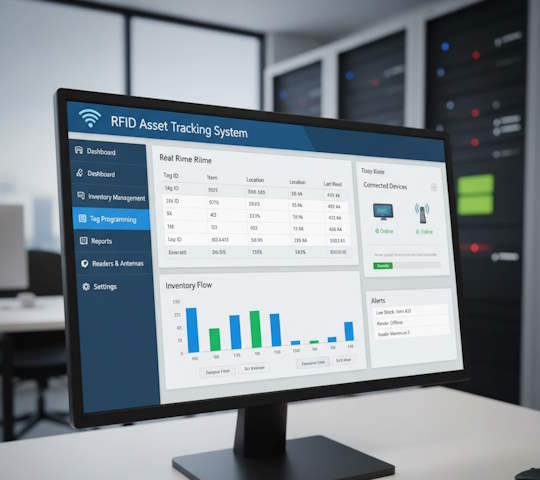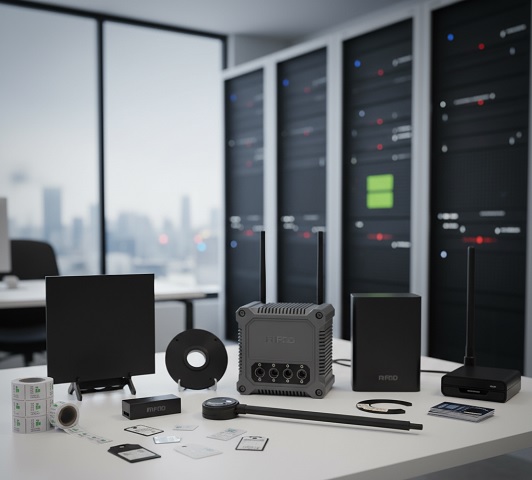GPIO in RFID Readers — Complete Guide to Automation and Integration
Author: Yurii Kasian, Industrial Automation Engineer
Date: October 15, 2025
Reading time: 14 minutes
🔍 What Is GPIO and How It Works in RFID Readers
GPIO (General Purpose Input/Output) are universal digital input/output ports that allow an RFID reader not only to read tags but also to control external devices such as locks, relays, indicators, and alarms.
- GPI (Inputs) — receive signals from sensors, buttons, or photoelectric devices.
- GPO (Outputs) — send commands to actuators and controllers.
Analogy: The RFID reader is the “brain,” and GPIO are its “eyes” and “hands,” enabling real-time interaction with the physical environment.
⚡ Why Use GPIO in RFID Systems
Thanks to GPIO, an RFID reader can act as an intelligent controller that can:
- start reading when an object is detected,
- unlock doors or gates after authorization,
- activate light or sound indicators,
- communicate with external systems (ACS, WMS, MES).
Benefits:
- Automation without a separate PLC
- Instant reaction to events
- Flexible system scalability
- Reduced controller costs
- High reliability with optical isolation
🔧 GPIO Types and Connection Examples
| Type | Purpose | Example |
|---|---|---|
| GPI (Input) | Receives signal from an external device | Photoelectric sensor, button, reed switch |
| GPO (Output) | Sends control signal | Locks, sirens, indicators, relays |
Typical specs: Voltage 5–30 V, current up to 1.5 A, optical isolation 2500 V.
⚙️ Proper GPIO Wiring and Setup
- Check port specifications before installation.
- Do not connect high-power devices directly — use opto-isolated relays.
- Ensure a common ground (GND) for reader, power supply, and devices.
- Add diodes for reverse current protection.
- Avoid overcurrent — a common cause of port damage.
📐 Wiring Schematics
- Indicator system: GPO1 — red (error), GPO2 — yellow (process), GPO3 — green (success).
- Access control (ACS): GPO1 → lock, GPO2 → green LED, GPO3 → red LED, GPI1 → Exit button.
- Conveyor automation: GPI1 — sensor signal, GPO1 — pusher control, GPO2–3 — visual indicators.
💻 GPIO Programming
Industrial Readers
reader.SetGPO(1, true); // Unlock
Thread.Sleep(5000);
reader.SetGPO(1, false); // LockDIY (Raspberry Pi + RC522)
GPIO.output(RELAY_PIN, GPIO.HIGH) # Unlock
time.sleep(5)
GPIO.output(RELAY_PIN, GPIO.LOW) # Lock🏭 Real-World Use Cases
1. Access Control
Authorized tag → unlocks door, green LED, short beep.
Unauthorized → red LED + alert.
Exit button → manual open.
Integration with video surveillance and time tracking.
2. Logistics and Warehousing
RFID on forklift → automatic pallet scanning.
GPI detects fork position, GPO controls alarm.
Results: –75% receiving time, –98% errors, +40% productivity.
3. Smart Manufacturing (Industry 4.0)
GPI: position sensors, GPO: pneumatic actuators and alerts. Integration with MES ensures complete traceability.
⚠️ Common Mistakes
| Mistake | Consequence | Solution |
|---|---|---|
| Overcurrent | Port burnout | Use relays |
| No common ground | False triggers | Connect all GNDs |
| Powering heavy load from GPIO | Overheating, malfunctions | Use separate power |
| No diodes | Back-EMF damage | Add protective diodes |
| Wrong polarity | Component failure | Check wiring |
📊 Specifications (Impinj R700)
| Parameter | Value |
|---|---|
| Ports | 3 isolated GPIO |
| Voltage | 5–30 V DC |
| Current | up to 1.5 A |
| Optical isolation | 2500 V |
| Protection | Short-circuit, surge, reverse polarity |
📈 Conclusion
GPIO is the key to RFID system automation. It enables readers not only to identify tags but also to manage events, alarms, and physical processes.
- Lower hardware costs
- Faster response time
- Scalable architecture
- Industrial-grade reliability
Future trends: wireless GPIO over Wi-Fi/Bluetooth, IoT integration, and AI-driven automation scenarios.
📚 Sources:
To confirm the technical veracity and provide deep-dive resources, the following authoritative sources are recommended:
- LLRP Specification (Low Level Reader Protocol).
The EPCglobal standard detailing the communication protocol between an RFID reader and client software.
LLRP Standard Specification (EPCglobal) - Impinj R700 Reader User Guide.
Official manufacturer documentation providing detailed GPIO wiring diagrams and electrical specifications, crucial for implementation.
Impinj R700 Reader User Guide (Impinj Support) - Industrial Control and Safety Best Practices.
General guidelines on electrical safety and installation best practices for low-voltage industrial control components.
NFPA 70: National Electrical Code (NEC) - IEC 61000 Standards.
International Electrotechnical Commission norms concerning electromagnetic compatibility (EMC), relevant for understanding opto-isolation and surge protection.
Overview of the IEC 61000 series (Electropedia)




